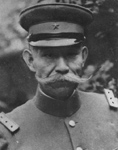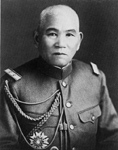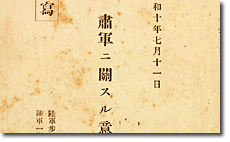HOME > Crisis in Constitutional Politics > b. Rise of the Military > Army Factional Infighting
4-5 Army Factional Infighting

Hayashi Senjuro. From "Rekidai Shushoto Shashin"(Collection of Modern Japanese Political History Materials Room)
("Portraits of Modern Japanese Historical Figures")

Masaki Zinzaburo. From "Masaki Zinzaburo Nikki. Showa 7, 8, 9nen 1gatsu - Showa 10nen 2gatsu"
On 20 November 1934 (Showa 9), several young Army officers, including Captain MURANAKA Koji and Paymaster First Class ISOBE Asaichi, along with a group of five cadets from the Army Military Academy, were arrested for attempting a coup d'etat. In that incident, called the Military Academy Incident or the November Incident, MURANAKA and ISOBE appealed from jail that they had been falsely accused. Saying that their were framed by Major KATAKURA Tadashi, Captain TSUJI Masanobu and others of the Control Faction to ensnare the Imperial Way Faction of which they were a part, and which centered on Military Affair Councilor ARAKI Sadao, Director General of Military Training MASAKI Jinzaburo, and Army Minister HAYASHI Senjuro. Although they were not charged with crimes of insurrection under the Army Penal Code, MURANAKA and the other officers were suspended from their duties, while the cadets involved were expelled from the Academy. In July 1935 (Showa 10), HAYASHI, who had stepped up his criticism of what he saw as the partisan personnel appointments made by ARAKI and MASAKI, won support from the anti-Imperial Way Faction in the Army and a group of senior statesmen (Jushin) and eventually forced MASAKI out of his position as Director General of Military Training.
This document, "Memorandum on the Army Purge", is a piece of politically defamatory literature written by MURANAKA and ISOBE after their release from jail and during their suspension from duty, and contains an expos of what they felt really happened in the Military School Incident and the attempted coup d'etat. Because of their writings, MURANAKA and ISOBE were finally dismissed from their posts. Nonetheless, the impact of the defamatory work was substantial, leading to the assassination of Director NAGATA Tetsuzan of the Military Affairs Bureau, a central figure in the Control Faction, by Lieutenant Colonel AIZAWA Saburo of the Imperial Way Faction. In addition, MURANAKA and ISOBE were instigators of the 2.26 Incident of 1936 along with other radical young officers.
Memorandum on the Army Purge, MURANAKA Koji and ISOBE Asaichi
- 11 July 1935 (Showa 10)
- Constitutional Government Documents Collection, #1201
- National Diet Library
